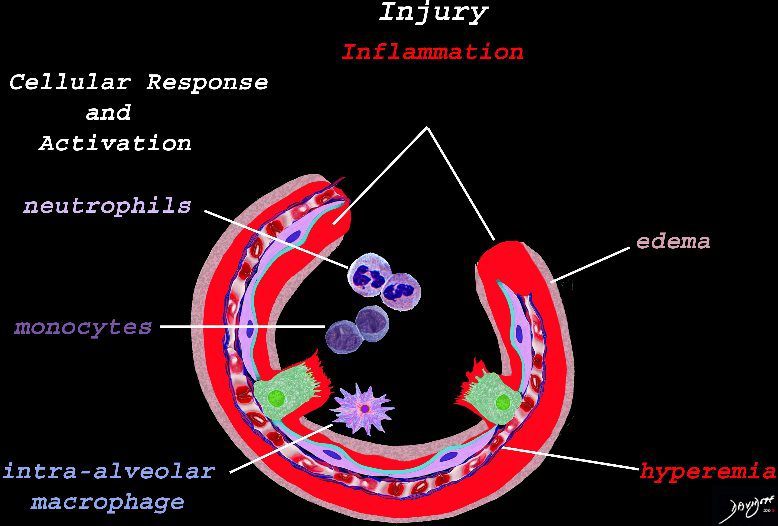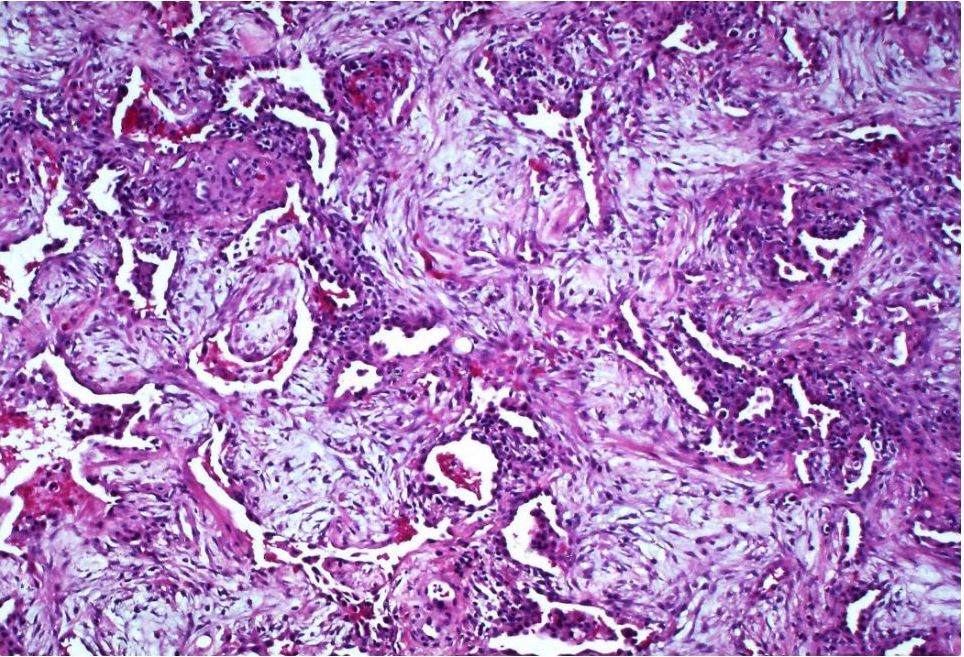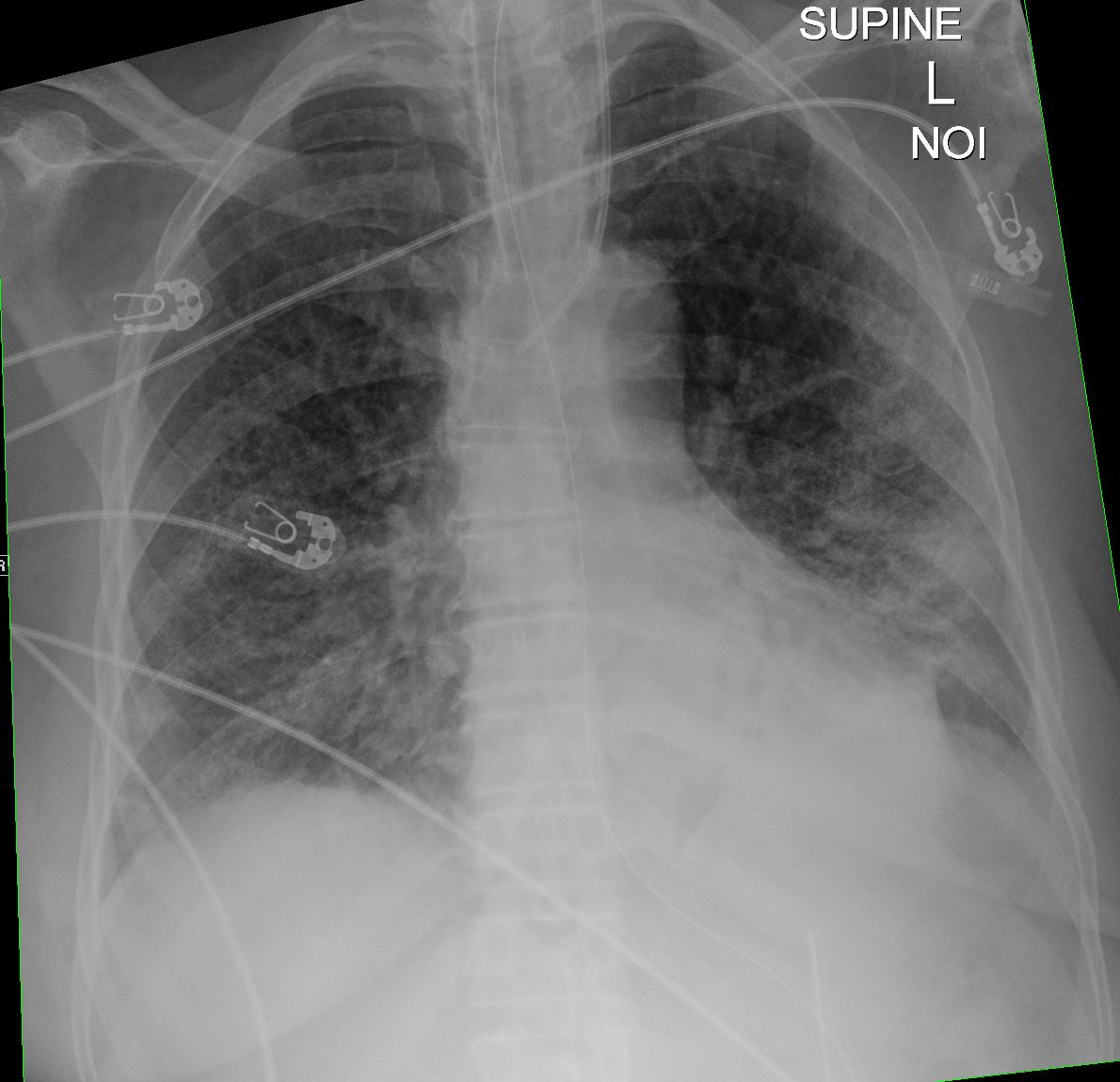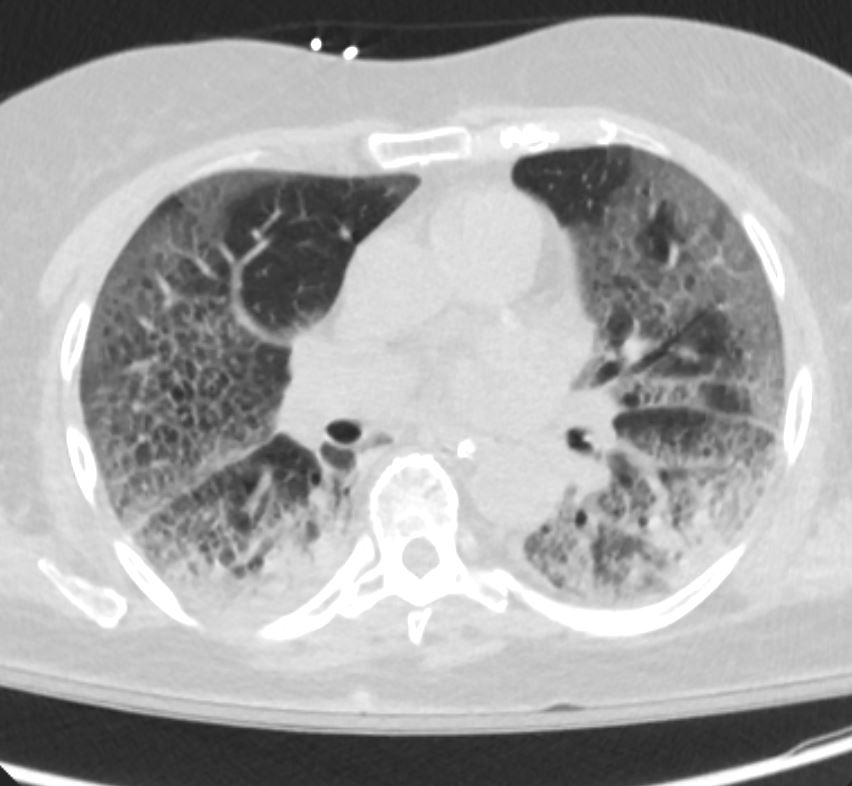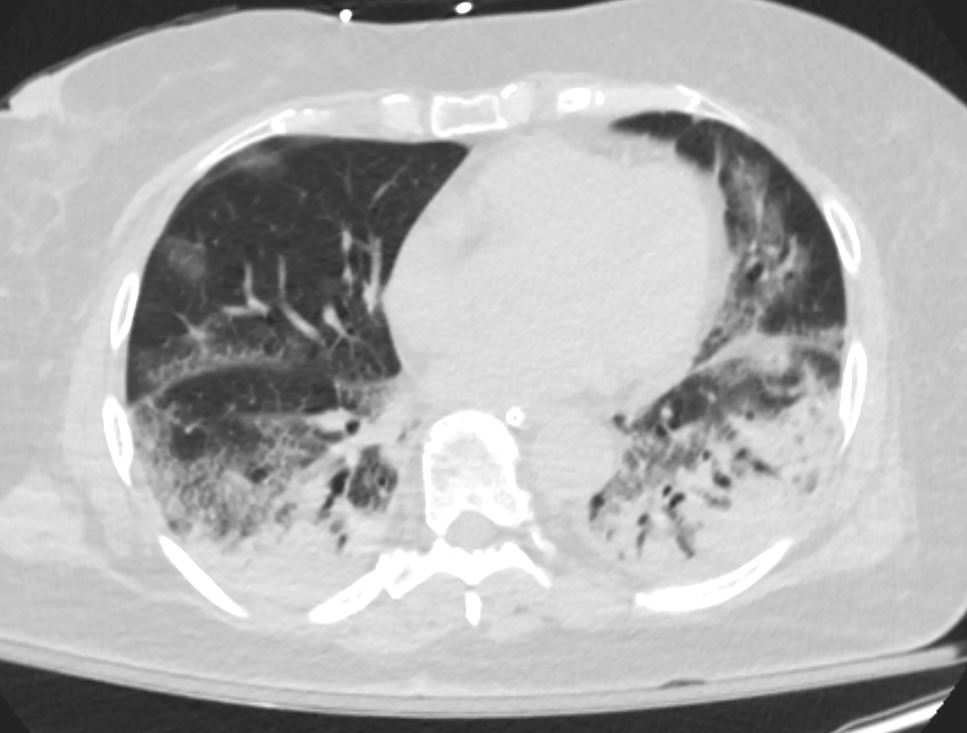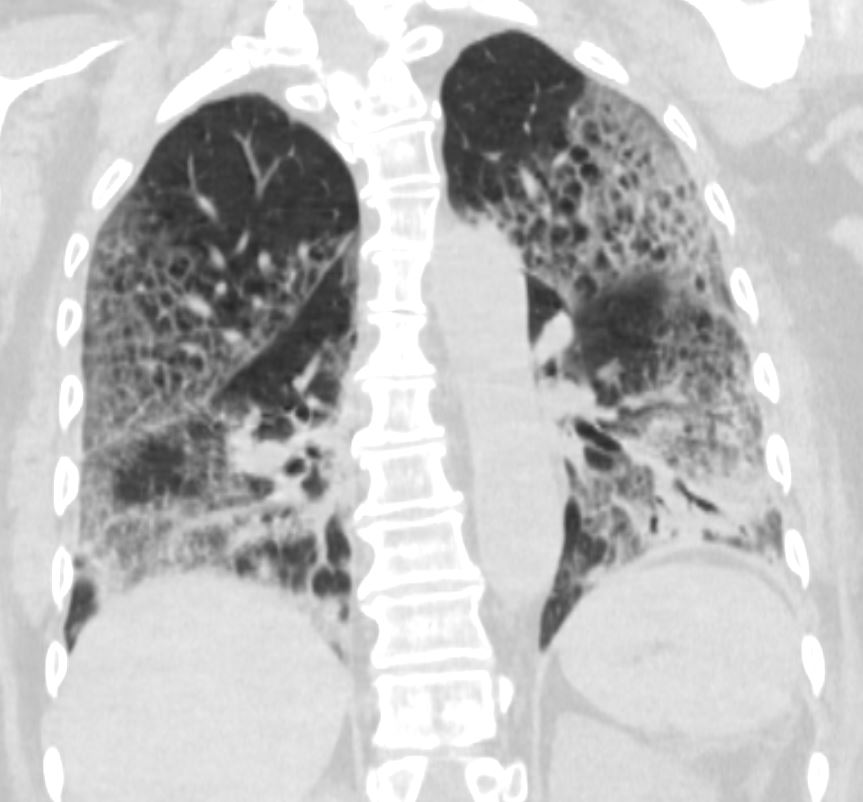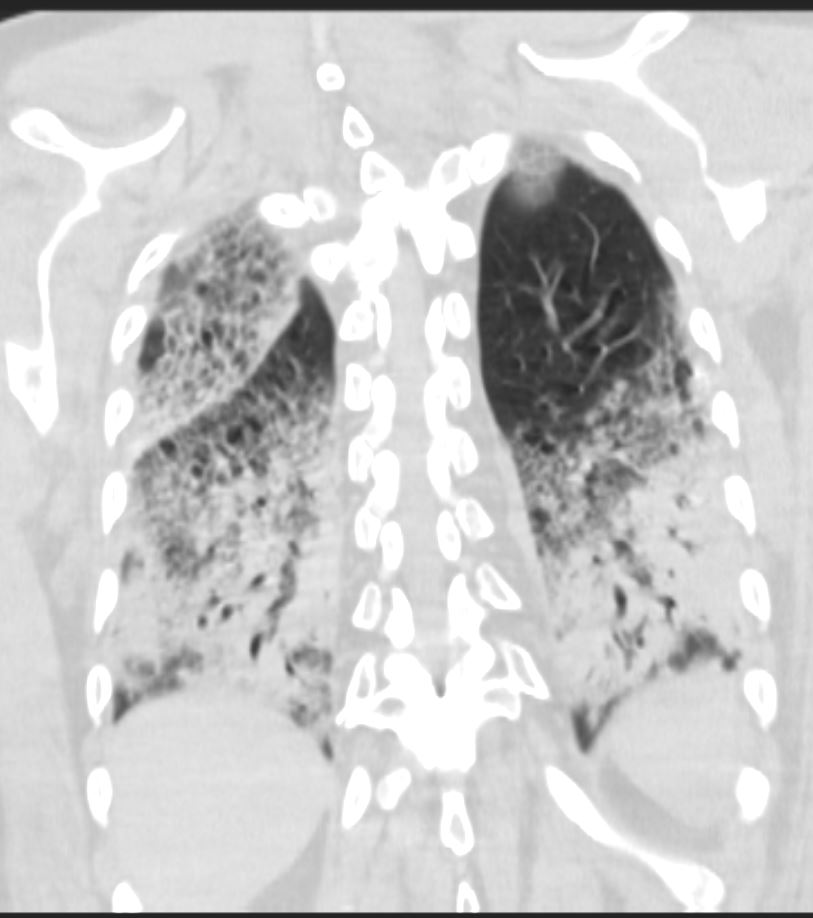- ARDS is a clinical syndrome with specific diagnostic criteria based on symptoms, imaging, and oxygen levels.
- DAD is a histological pattern of lung injury, most commonly seen in ARDS but not exclusively limited to it.
- ARDS is characterized by an
- acute and diffuse inflammatory damage
- into the alveolar-capillary barrier
- increased vascular permeability
- Caused by
-
- direct (pulmonary ARDS) or
- indirect (nonpulmonary ARDS),
- Most Common
-
- Resulting in
- early changes
- diffuse bilateral coalescent opacities
- caused by proteinaceous interstitial edema
- (not reversible by treatment with diuretics)
- after about a week
- developing into alveolar edema due to pneumocyte type 1 damage and
- resulting in hyaline membrane disease
- early changes
- CT
- Two basic forms
- Direct pulmonary disease caused by pulmonary factors
- more heterogeneous asymmetrical distribution
- Indirect caused by a systemic ailment
- results in a more diffuse homogeneous process with symmetrical distribution
- Direct pulmonary disease caused by pulmonary factors
- Acute Phase
Early phase
- Two basic forms
Anteroposterior density gradient
Ground Glass Opacities
Dense consolidation in the most dependent regions, merging Subpleural Sparing
Normal or hyperexpanded lung in the non-dependent regions
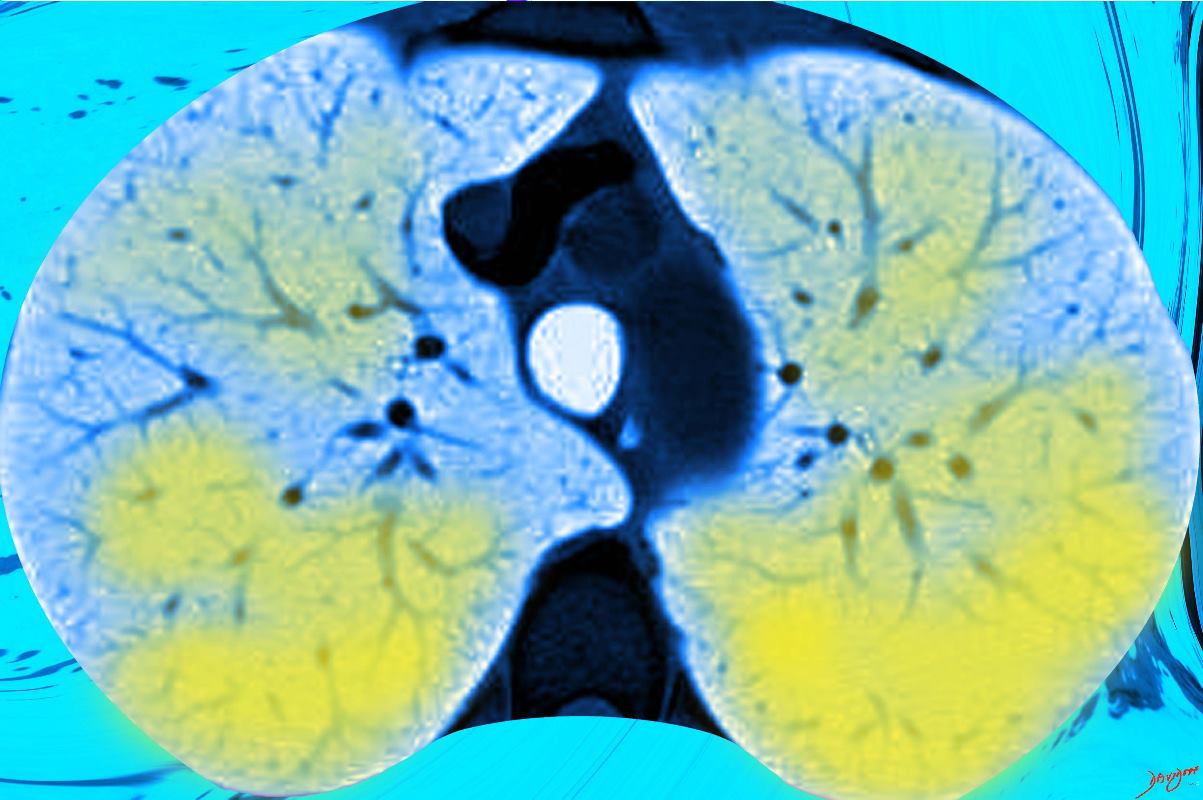
Since the patient is mostly in a supine position in the ICU setting the disease is distributed based on gravitational forces with the more dense consolidation in the most dependent regions posteriorly and less dense with ground glass changes anteriorly. Anteriorly more normal or even hyperexpanded lung is present.
Ashley Davidoff TheCommonVein.net lungs-0786
Memory Image
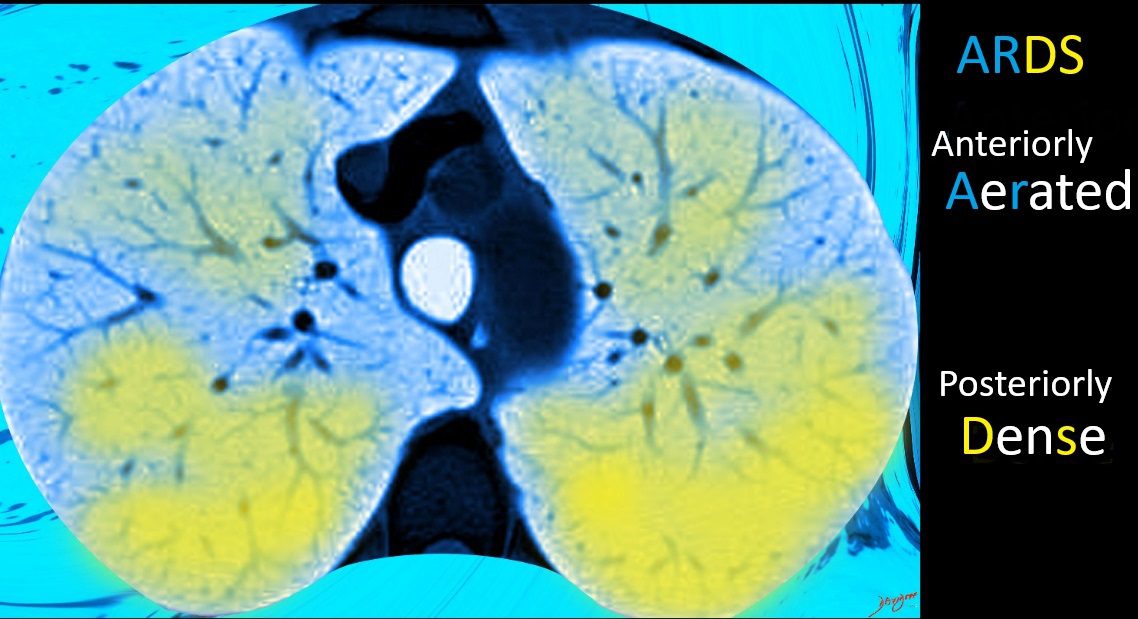
A Memory Image for ARDS
The anterior aspect of a CT in axial projection shows AeRation and the posterior aspect shows increase DenSity due to the gravitational effect of the fluid in the lungs
Ashley Davidoff TheCommonVein.net lungs-0786-01L
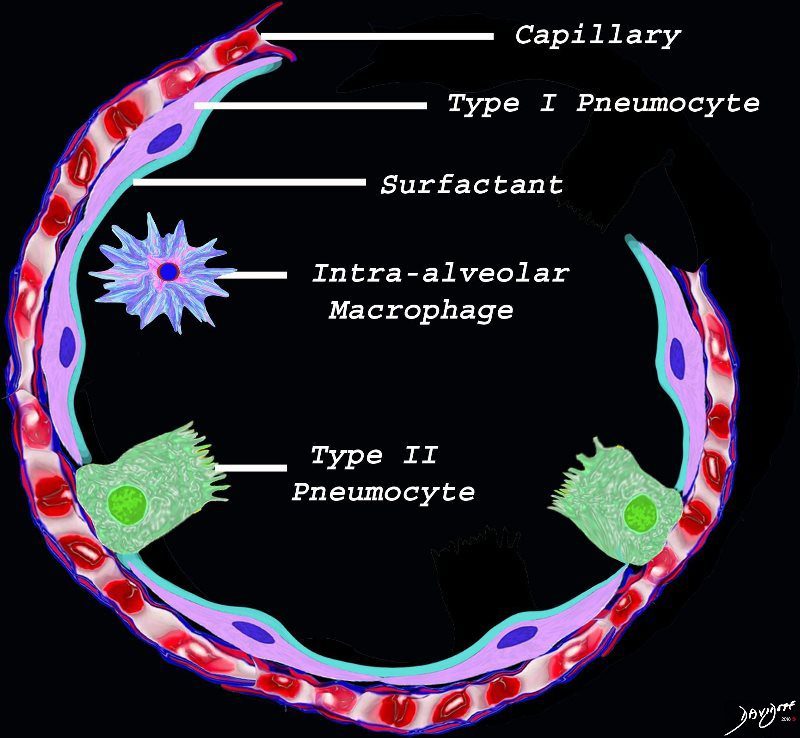
The diagram shows the lining of the normal alveolus composed of type 1 pneumocyte squamous in nature and the cuboidal cell (type pneumocyte) which rest on a lamina propria, and basement membrane (not shown) shared with the inner endothelial layer of the capillary. Intra-alveolar macrophage lies within the alveolar lumen
Ashley Davidoff
TheCommonVein.net
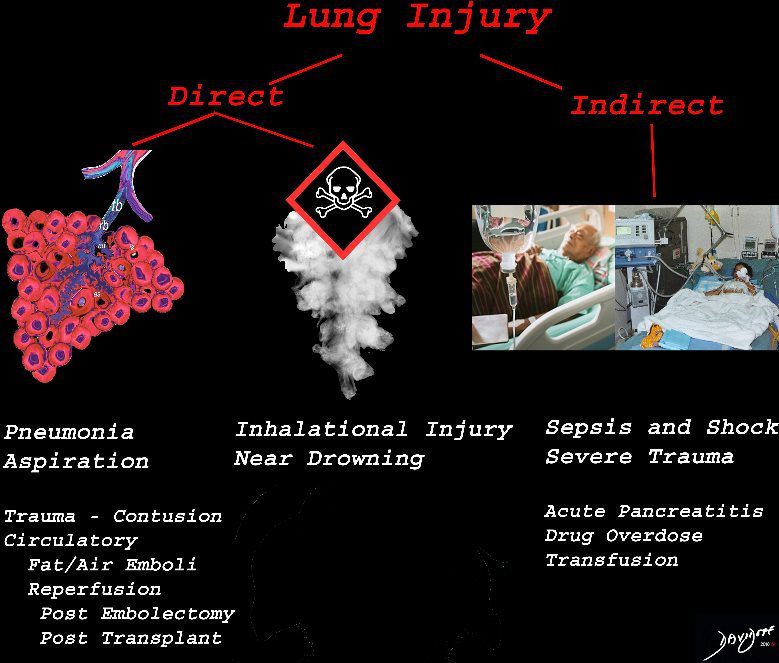
The lung is injured either by direst causes most commonly pneumonia, aspiration or from inhalation of toxic substances. Severe systemic illnesses, most commonly sepsis with shock, and severe trauma are considered indirect causes.
Ashley Davidoff
TheCommonVein.net
-
- Exudative (acute) phase: 1 – 7 days
-

Early Events in the Pathophysiology of the ARDS
The initial injury results in an acute severe inflammatory response consisting hyperemia , edema with migration initially of neutrophils in the first 6-24 hours followed by monocytes (24-48hours). The intra -alveolar macrophages are activated.
Ashley Davidoff
TheCommonVein.net
Result of Cellular Response
The cells of the immune system release cytokines, chemotactic agents and proteases. Immune cells , macrophages and fibroblasts are attracted to the interstitium. Some of proinflammatory agents are toxic to the cell lining causing damage to the surfactant, type 1 pneumocytes and the capillary endothelium. There is progressive edema.
Ashley Davidoff
TheCommonVein.net
Result of Cellular Response and Associated Tissue Injury
The damage to the endothelium of the capillary results in bleeding into the alveoli. The severe tissue damage and fluid exudation results in protein rich intra-alveolar fluid . The fibroblasts start to lay down collagen as part of the early repair process
Ashley Davidoff
TheCommonVein.net
Hyaline Membrane
A hyaline membrane evolves covering the damaged surface of the alveolus. This impedes gas exchange
Ashley Davidoff
TheCommonVein.netRadiology and Pathology
-
- Exudative (acute) phase: 1 – 7 days
Neutrophil mediated inflammation
-
-
- neutrophils predominate in the first 6 to 24 hours
- (monocytes predominate in 24-48 hours)
- Neutrophils destroys the alveolar capillary barrier (alveolar epithelium and endothelium),
- increases its permeability
- results in intra-alveolar hemorrhage and
- edema
- interacts with alveolar surfactants,
- resulting in decreased pulmonary compliance
- hyaline membranes develop in the alveolar wall
- neutrophils predominate in the first 6 to 24 hours
-
- Proliferative / organizing (subacute) phase: 8-14 days
- restoration of type II pneumocytes a
- differentiation into type I pneumocytes
- proliferation of myofibroblasts
-
Exudate

Acute Exudative Phase
Ashley Davidoff TheCommonVein.net 32816
Exudate and Hyaline Membranes
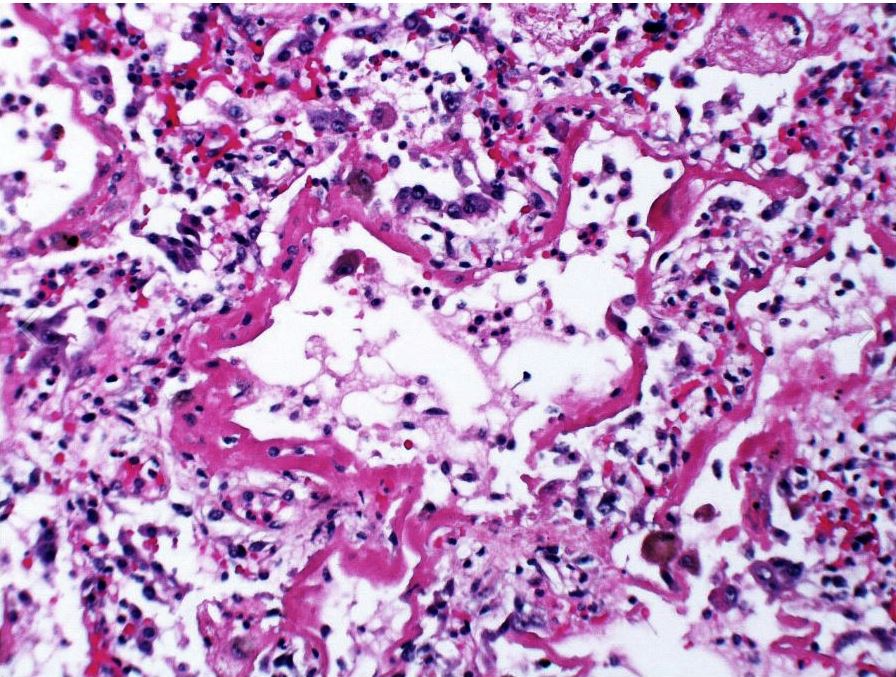
Courtesy Dr Yale Rosen
Mucus Like Exudate creating a Shiny Surface

Ashley Davidoff TheCommonVein.net 32817
Myofibroblast Proliferation

Courtesy Akira Yoshikawa
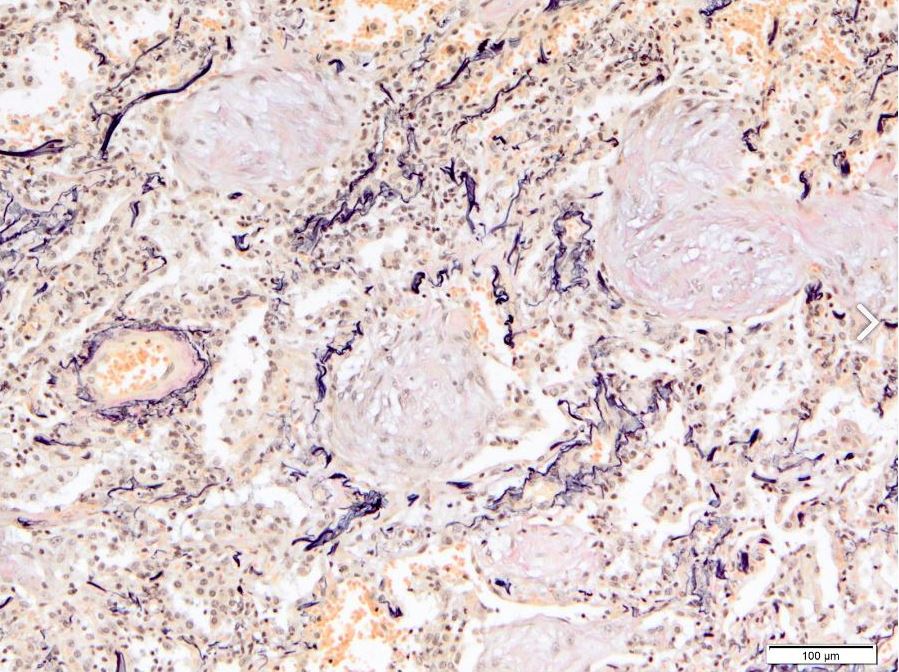
Courtesy Akira Yoshikawa
53 F ARDS Acute Exudative Phase
Ground Glass Pattern Basilar Consolidation (A-P gradient) and Subpleural Sparing
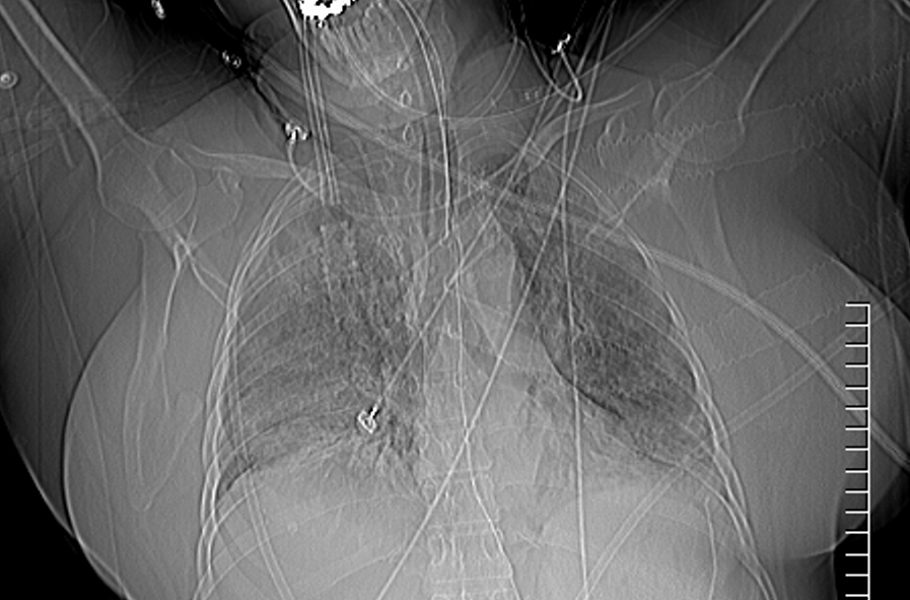
Diffuse Ground Glass Pattern
Ashley Davidoff TheCommonVein.net 134237
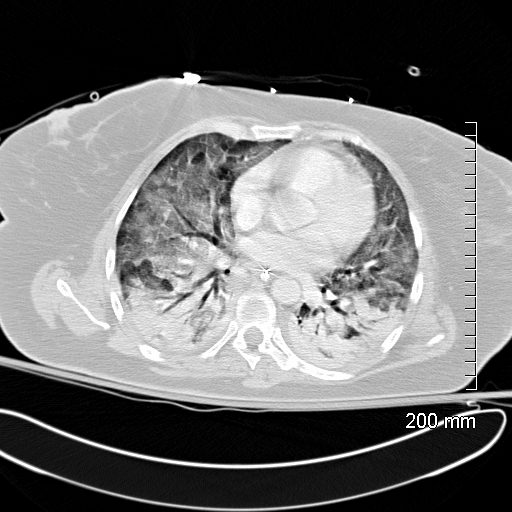
Diffuse Ground Glass Pattern and A-P gradient
Ashley Davidoff TheCommonVein.net 134245
Chronic Fibrotic Phase
- Fibrotic (chronic) phase: after 3 weeks
- Collagenous fibrosis in
- alveolar spaces and
- interstitium
- rigidity of alveoli due to architectural remodeling
- Collagenous fibrosis in
8 Months Later – Diffuse Ground Glass Pattern with Mild Traction Bronchiectasis
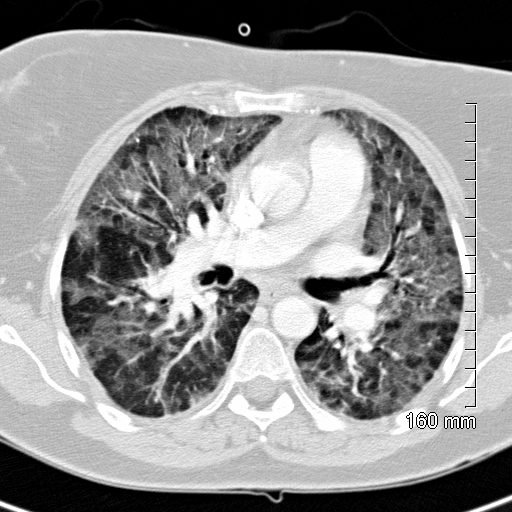
Diffuse Ground Glass Pattern with Mild Traction Bronchiectasis
Ashley Davidoff TheCommonVein.net 134262
Post MVA 58M Acute Exudative Phase

Diffuse Ground Glass Pattern Post MVA
Ashley Davidoff TheCommonVein.net 134269
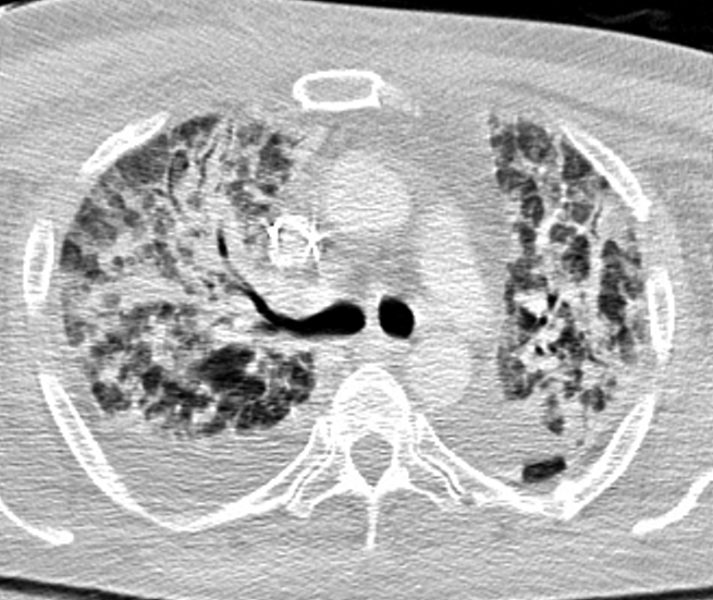
58M Diffuse Ground Glass Pattern Peribronchovascular Infiltrates
Focal Consolidation and Effusion
Ashley Davidoff TheCommonVein.net 134273
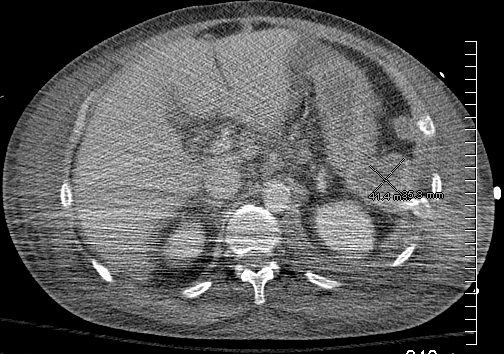
58M 3rd Spacing in the Subcutaneous Tissue
Ashley Davidoff TheCommonVein.net 134270
Post MVA 12 Days Later – Improving Non Cardiogenic Edema and Third Spacing

12 Days later
Still Intubated
Ashley Davidoff
TheCommonVein.net
134282
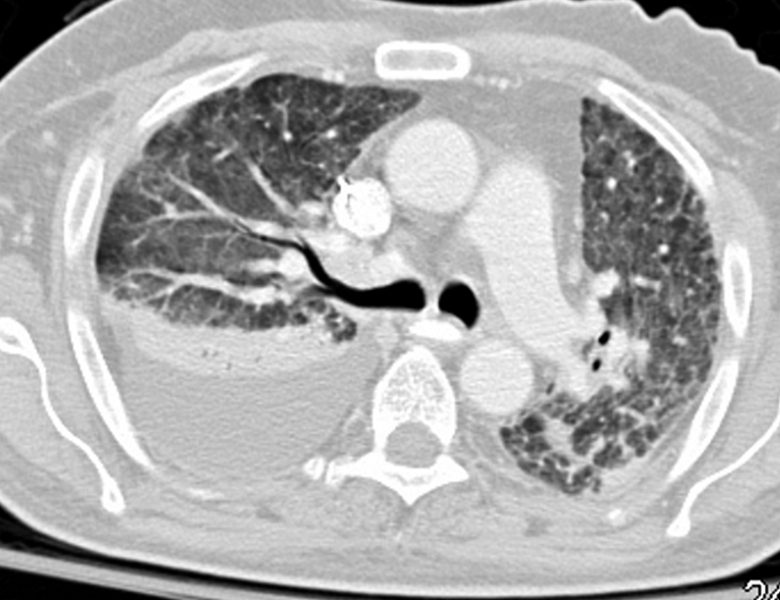
Improved Diffuse Ground Glass Pattern
Ashley Davidoff TheCommonVein.net 134284
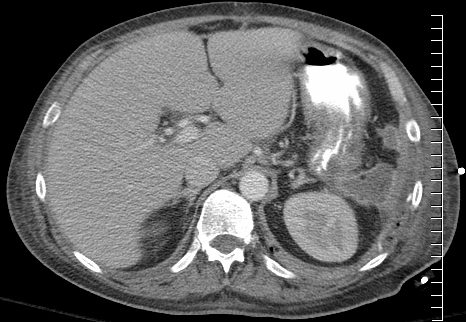
Improved subcutaneous 3rd spacing of fluids
Organized collection in the LUQ
Ashley Davidoff TheCommonVein.net 134281
ARDS – Dominant Central Distribution with Relative Lower Lobe Subpleural Sparing
79 Year Old Male 2 Weeks Earlier in CHF
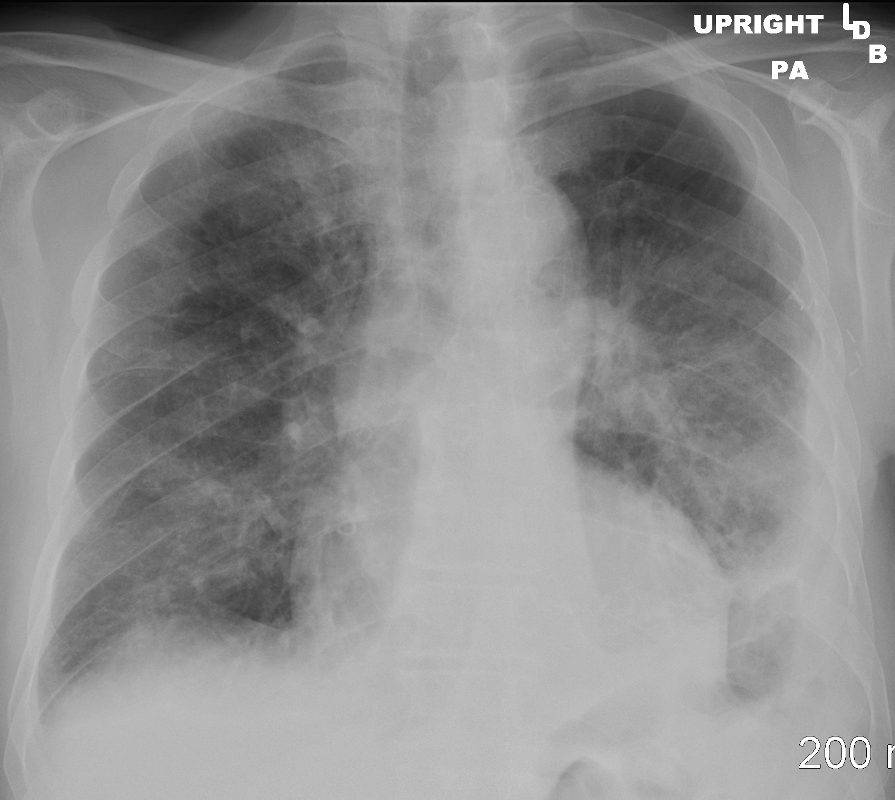
CXR shows Cardiomegaly CHF, with interstitial edema and complex left effusion
Ashley Davidoff TheCommonVein.net 134304a
Patient Developed Sepsis and 2 Weeks Later Radiological Features of ARDS
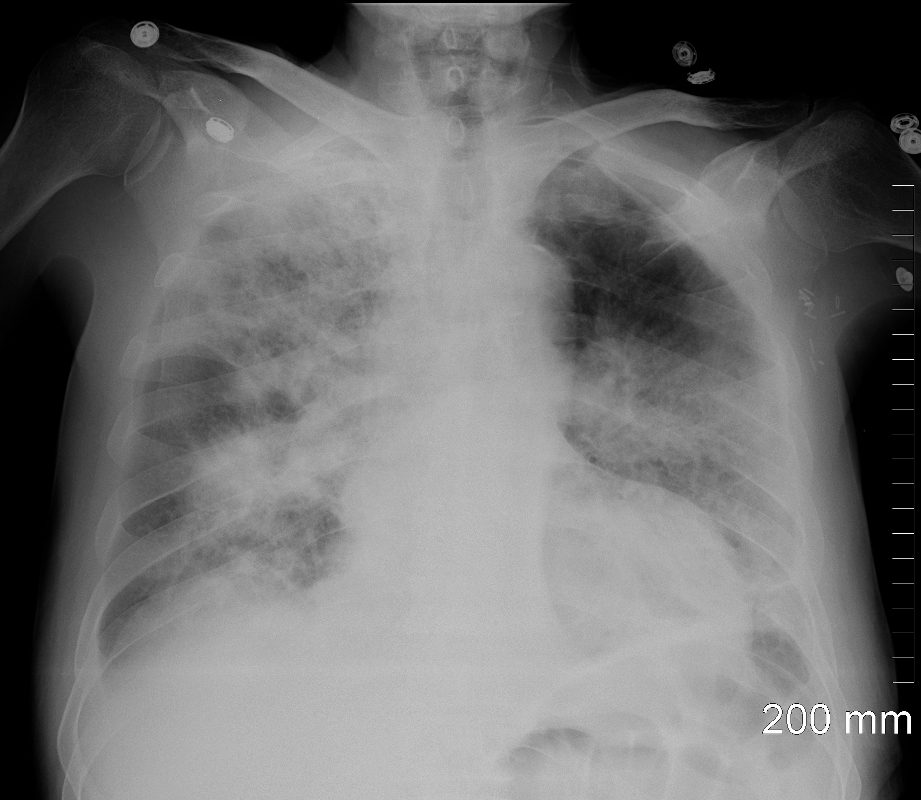
Patchy Diffuse Ground Glass Pattern
Dominant – Central Location
Relative Lower Lobes and Subpleural Sparing
Ashley Davidoff TheCommonVein.net 134304
Diffuse Ground Glass Changes Subpleural Sparing
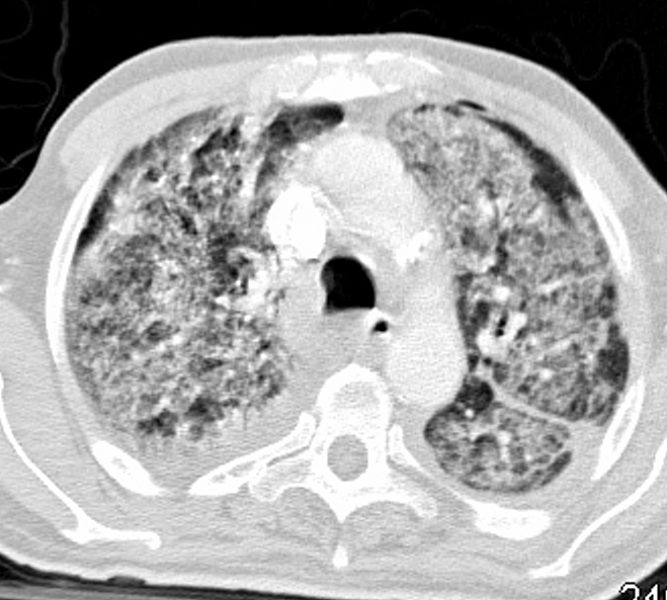
Patchy Diffuse Ground Glass Pattern, thickened interlobular septa
Subpleural Sparing
Ashley Davidoff TheCommonVein.net 134294
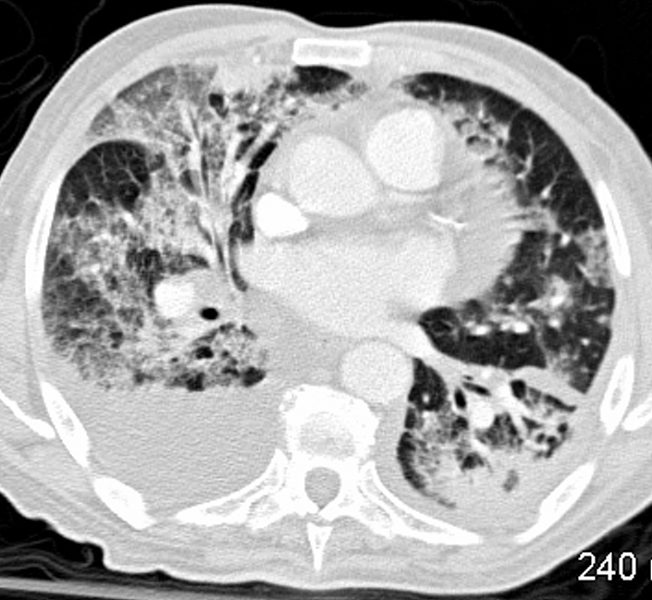
Patchy Diffuse Ground Glass Pattern and right pleural effusion
Ashley Davidoff TheCommonVein.net 134300
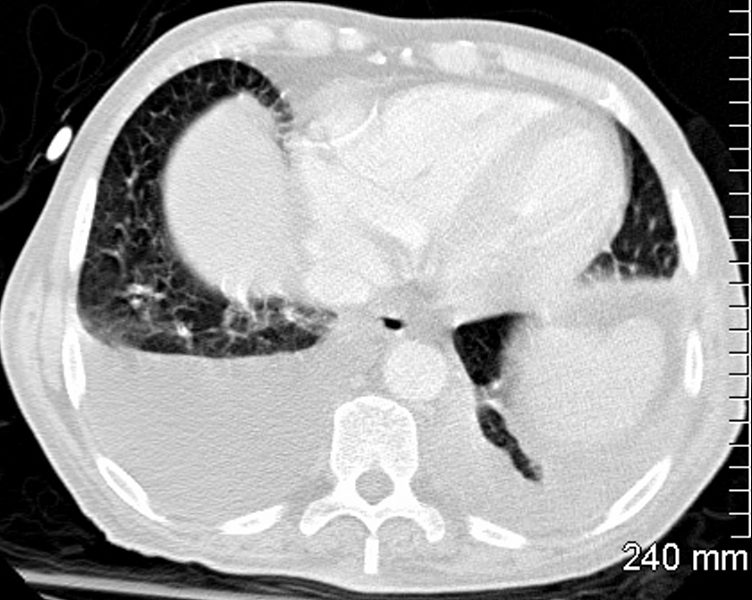
Relative Lower Lobes Sparing with bilateral pleural effusions
Ashley Davidoff TheCommonVein.net 134301
54 Year Old Female with sepsis, ARDS and
A-P Density Gradient
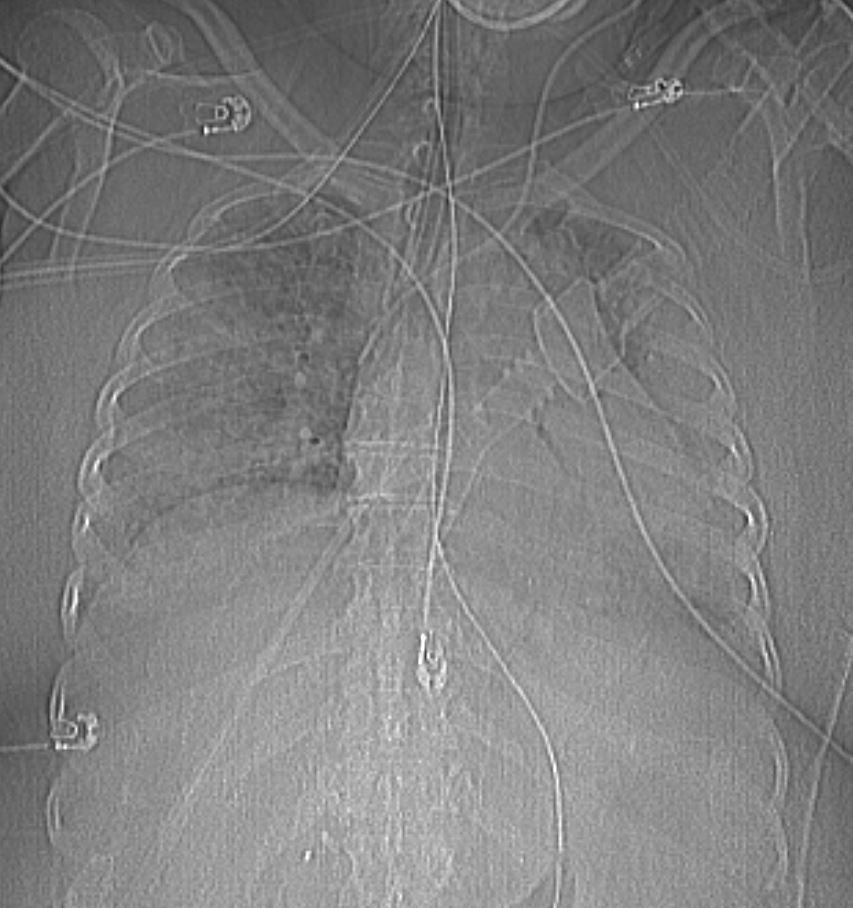
Ashley Davidoff TheCommonVein.net 54-f001-ARDS
Ground Glass Pattern with Patchy Infiltrates and A-P Gradient
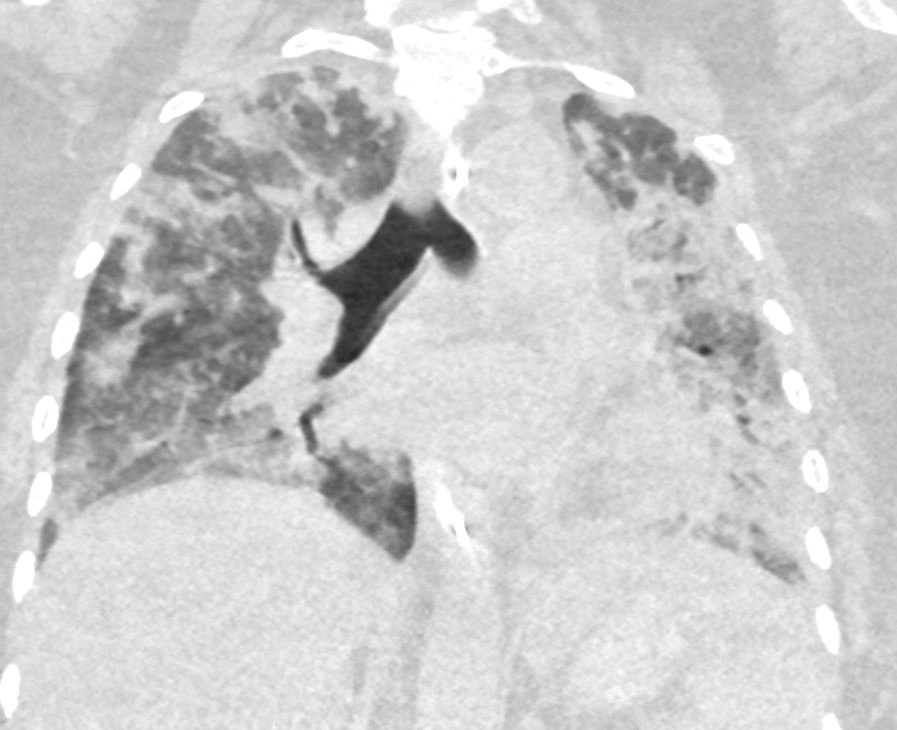
54 year old female with sepsis and acute respiratory distress syndrome. Coronal CT shows diffuse ground glass changes with subsegmental regions of consolidation. The posterior aspect of the lungs showed consolidation characteristic of the antero-posterior density gradient of ARDS Ashley Davidoff TheCommonVein.net ARDS-54-f002
MVA ARDS Bibasilar Consolidation and A-P Density Gradient
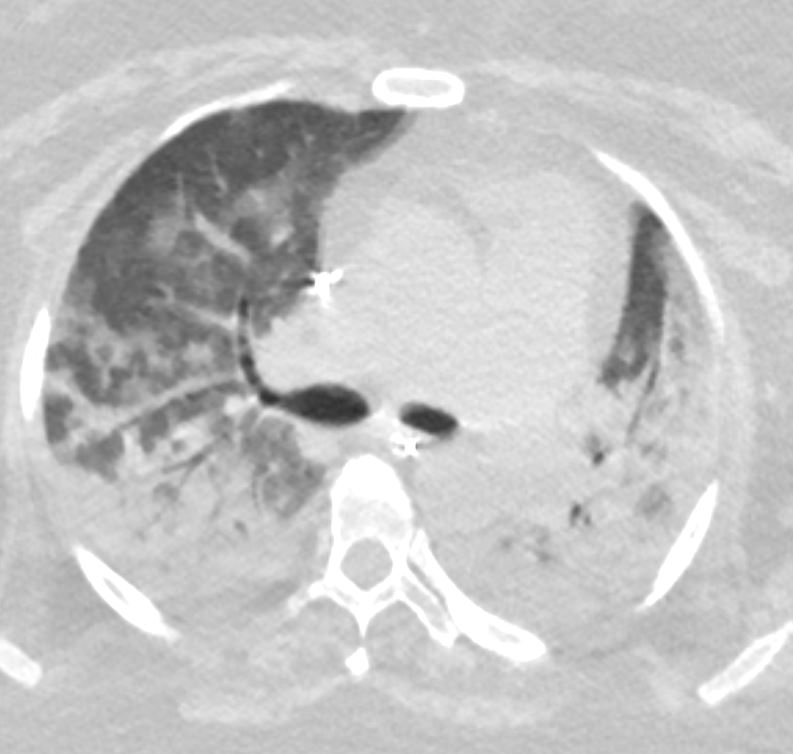
54 year old female with sepsis and acute respiratory distress syndrome . Axial CT at the level of the carina shows ground glass changes and bilateral posterior consolidation reminiscent of an antero-posterior density gradient – a characteristic radiological finding of ARDS Ashley Davidoff TheCommonVein.net 54-f003-ARDS
AIP ARDS Immunotherapy Toxicity
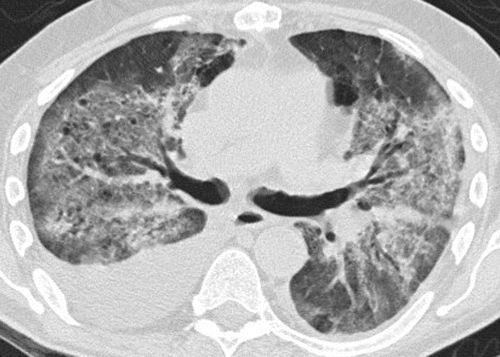
Pneumonitis in a 65-year-old man with diffuse large B-cell lymphoma after three cycles of rituximab with cyclophosphamide, doxorubicin hydrochloride, vincristine sulfate, and prednisone (R-CHOP) therapy who presented with new shortness of breath. Axial CT image shows bilateral diffuse GGOs and areas of consolidation in both lungs, with traction bronchiectasis and loss of lung volumes. The findings reflect an AIP/ARDS pattern of pneumonitis related to rituximab. Bilateral pleural effusions were also present. The patient’s condition significantly deteriorated, and he died 1 month after presentation. Autopsy results showed diffuse alveolar damage in the lungs.
Nishino, M et al Thoracic Complications of Precision Cancer Therapies: A Practical Guide for Radiologists in the New Era of Cancer Care Radio Graphics Vol. 37, No. 5
Diffuse Ground Glass ARDS vs Atypical Pneumonia
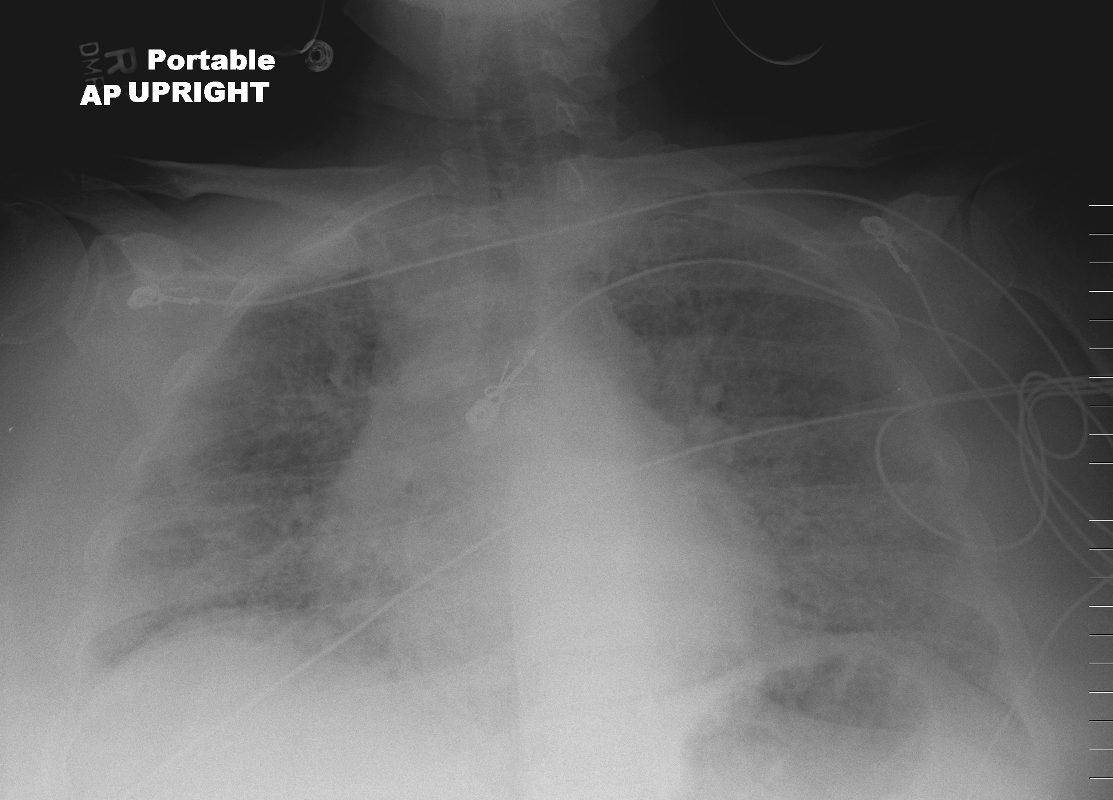
43F
Diffuse Ground Glass Pattern
Ashley Davidoff
TheCommonVein.net
117653
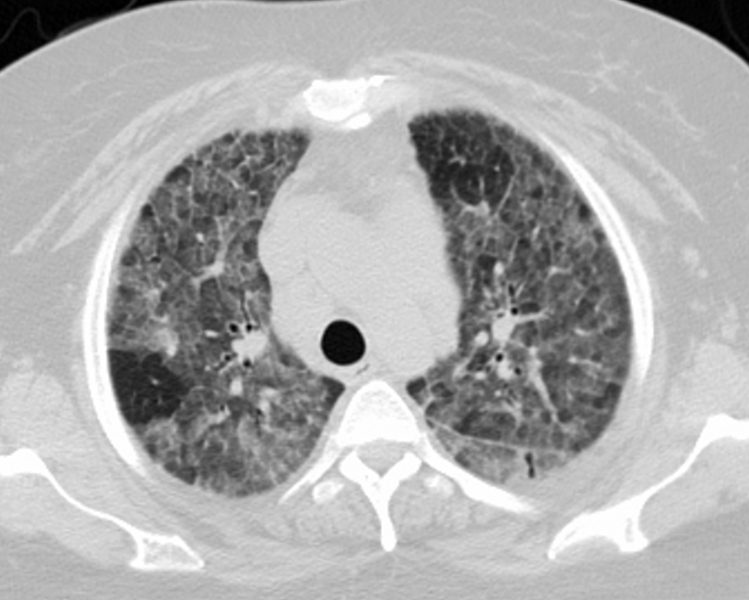
43F
Diffuse Ground Glass Pattern
Mosaic Attenuation
Ashley Davidoff
TheCommonVein.net
117662
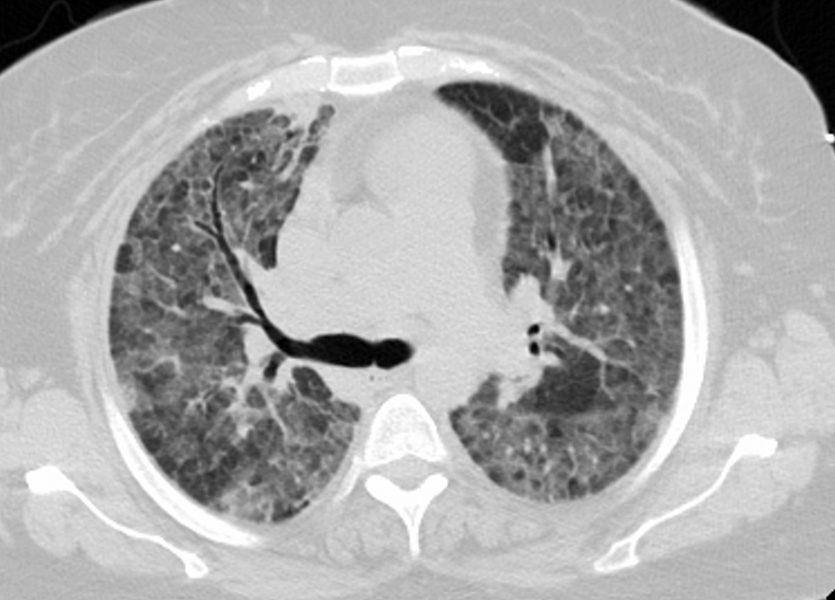
43F
Diffuse Ground Glass Pattern
Mosaic Attenuation
Ashley Davidoff
TheCommonVein.net
117668

43F
Diffuse Ground Glass Pattern
Mosaic Attenuation
Ashley Davidoff
TheCommonVein.net117672
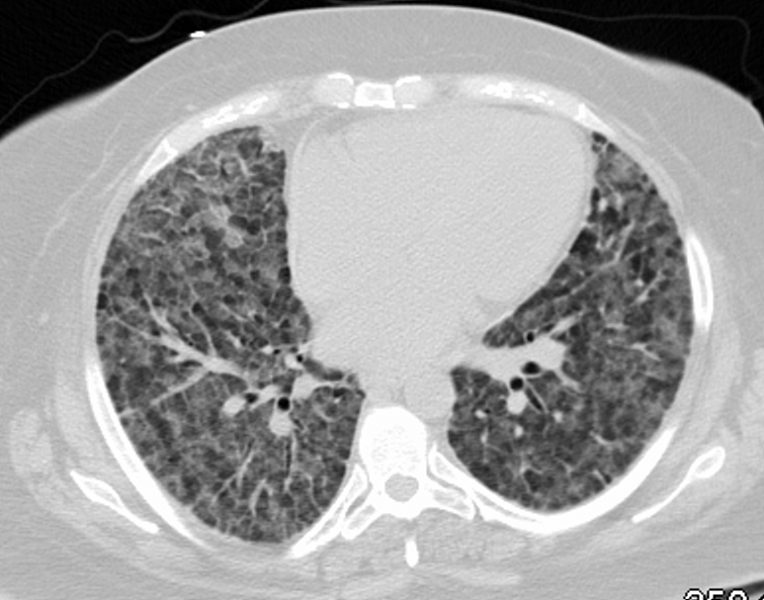
43F
Diffuse Ground Glass Pattern
Ashley Davidoff
TheCommonVein.net
117687
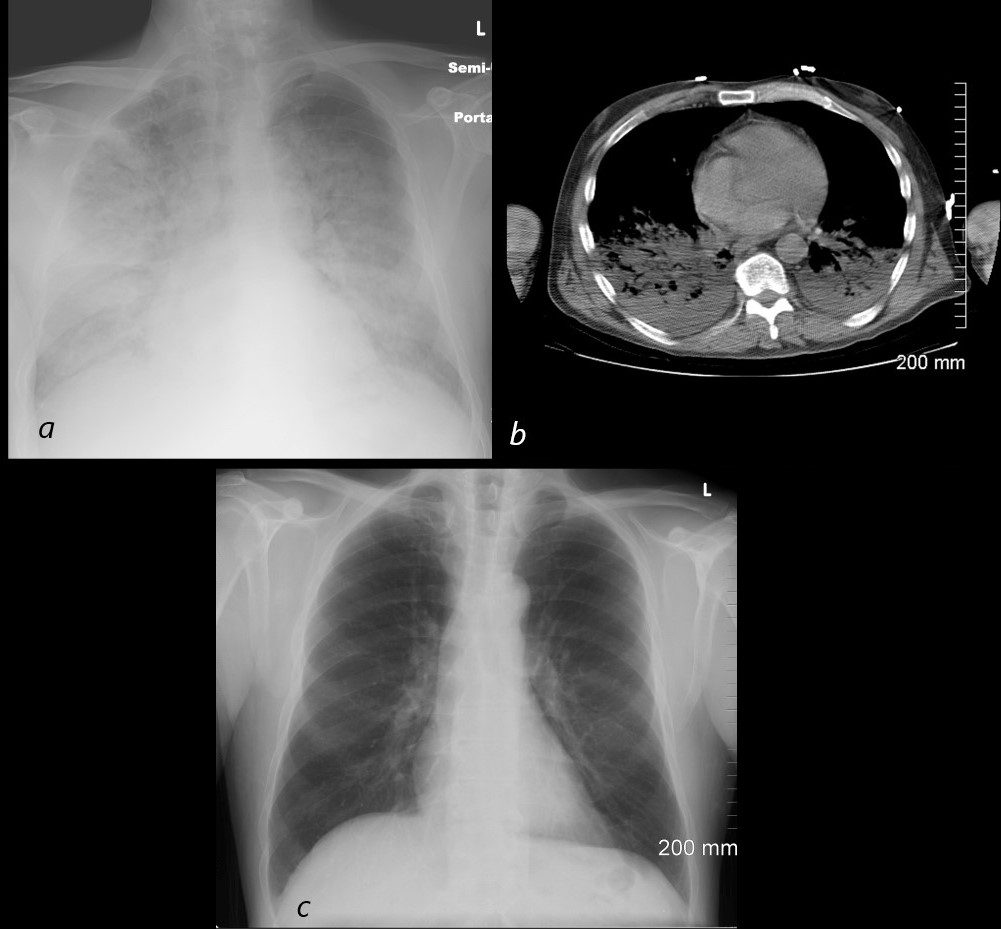
54 year old male alcoholic with seizures presents with diffuse alveolar disease consistent with pulmonary edema (a). CT scan (b) shows bibasilar infiltrates consistent with aspiration.
Follow up CXR 6 months later (c) shows resolution
Ashley Davidoff MD TheCommonVein.net
70F Aspiration and Pneumonia with Crazy paving
62F-ARDS-post-abdominal-surgery-and-abdominal -abscess-shock
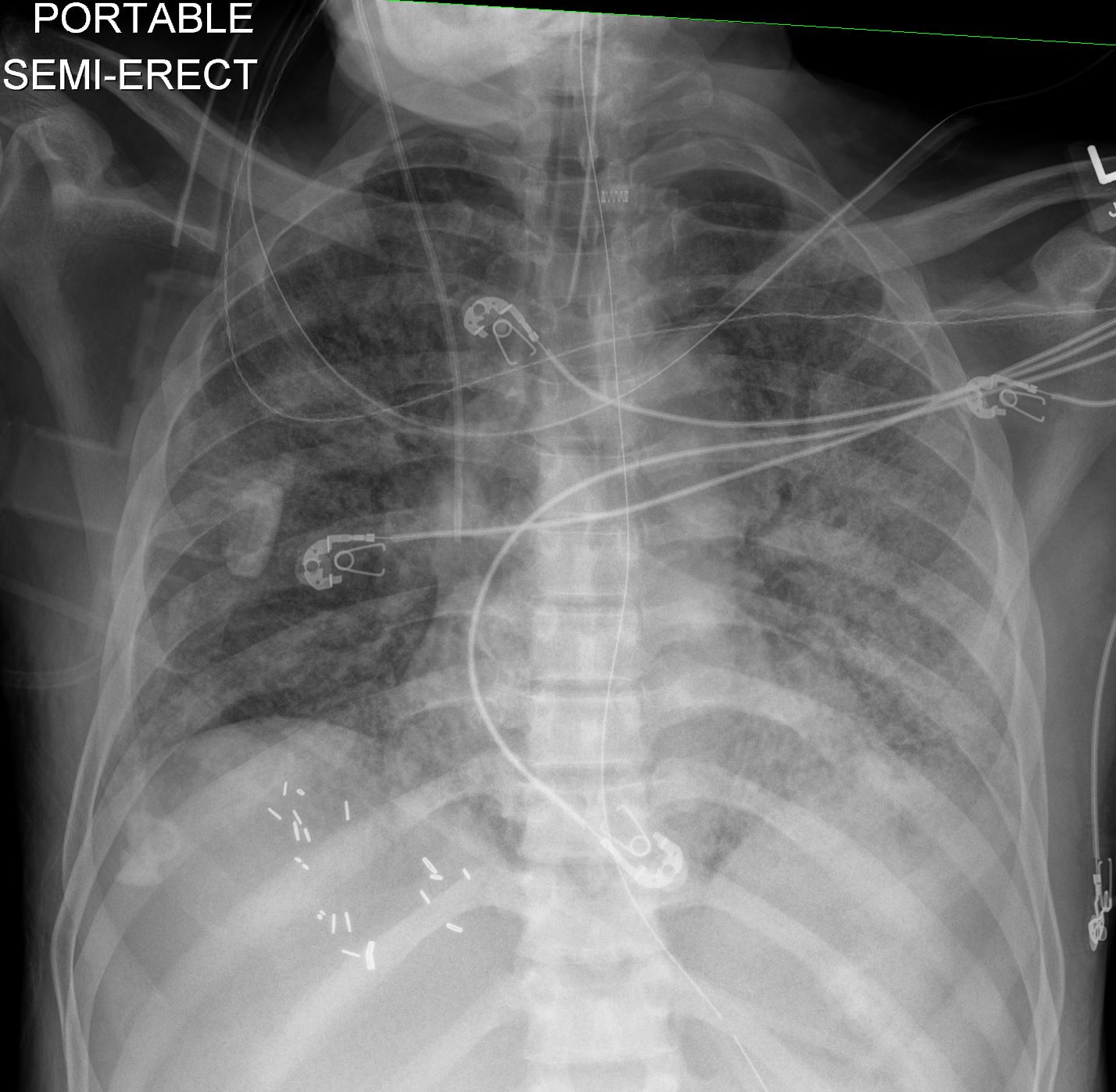
post-abdominal-surgery-and-abdominal -abscess-shock
Ashley Davidoff MD TheCommonVein.net
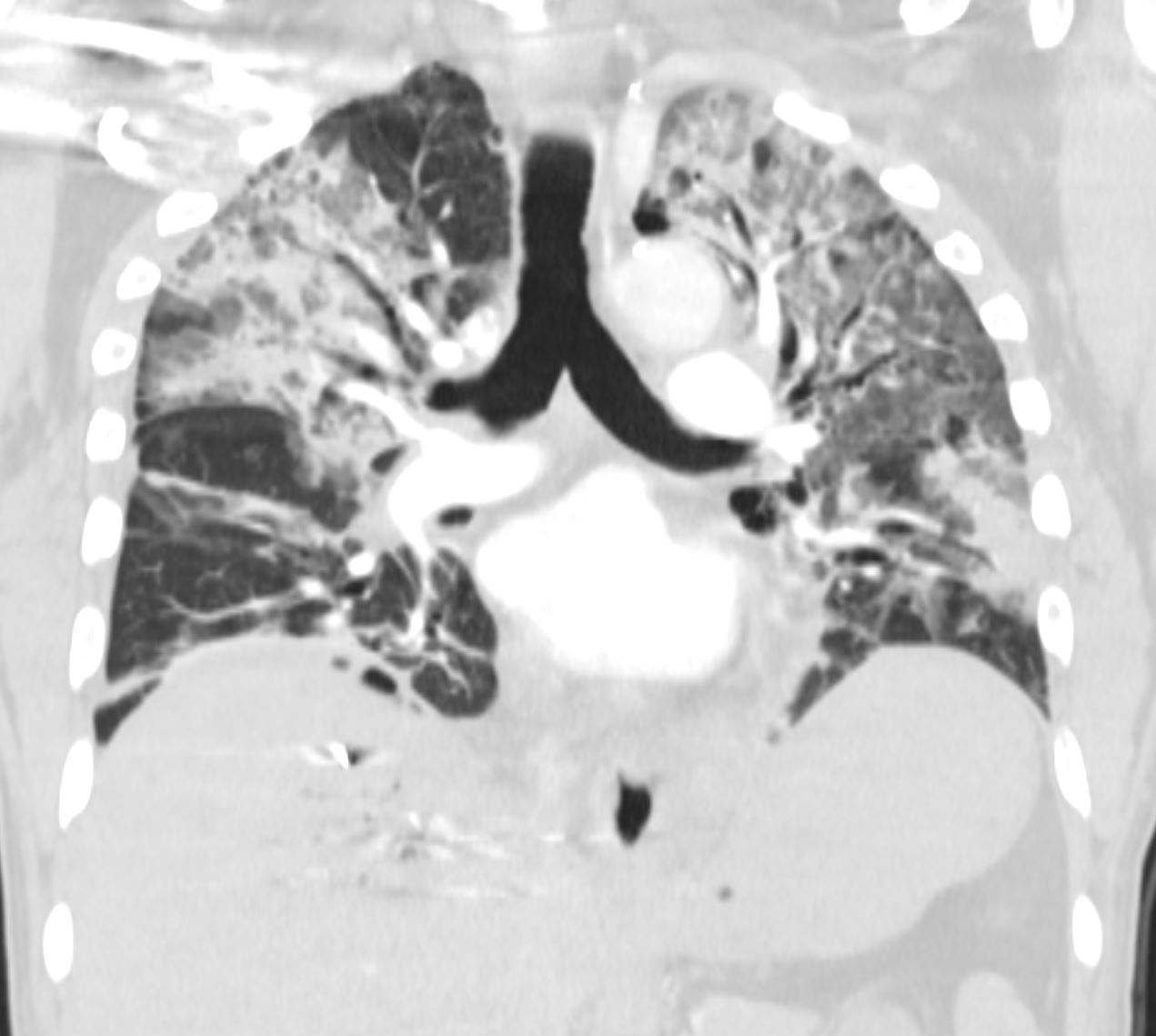
post-abdominal-surgery-and-abdominal -abscess-shock
Ashley Davidoff MD TheCommonVein.net
Ground-glass Opacification Consolidation and Subpleural Sparing
Secondary to Trauma
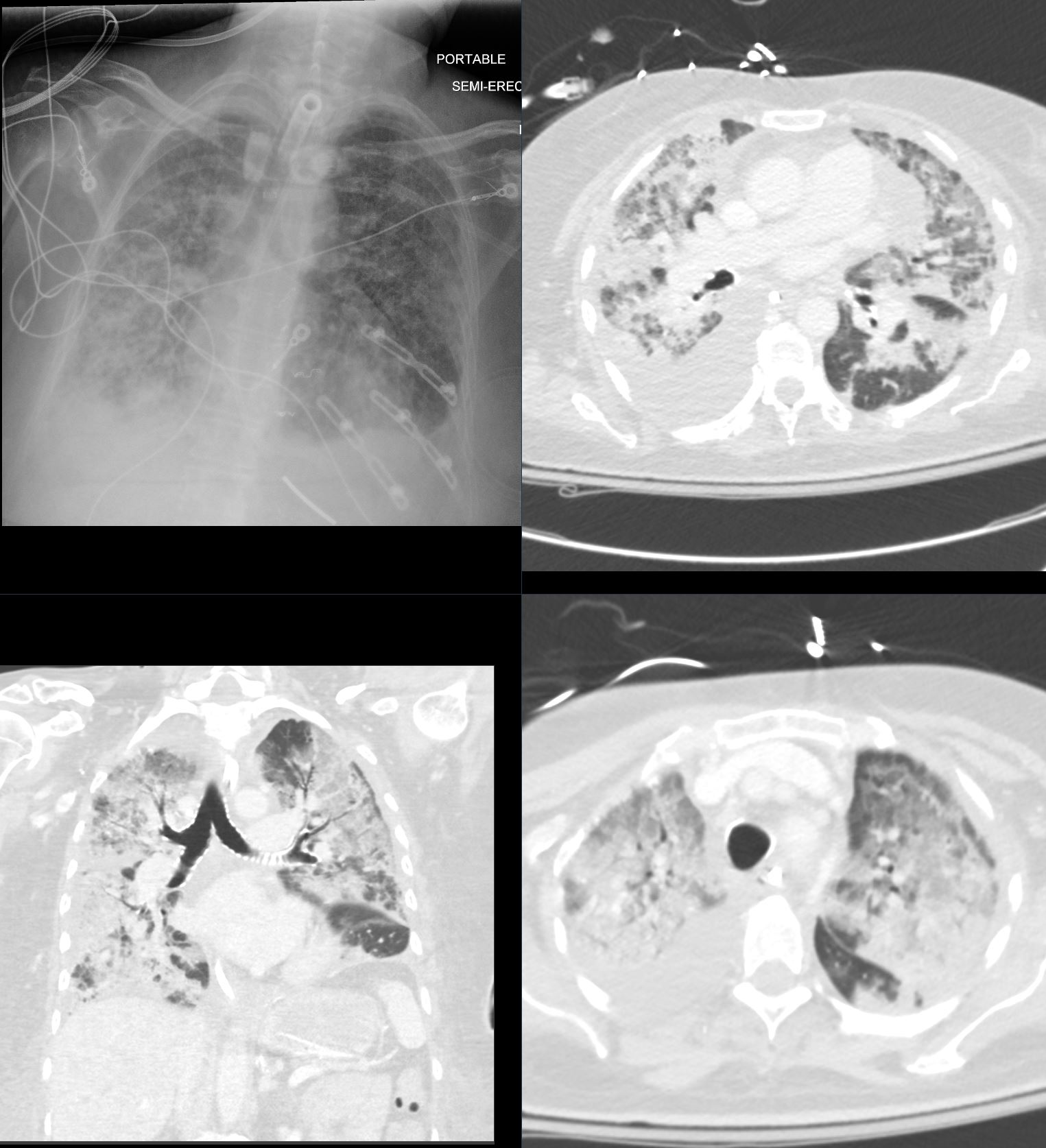
CXR and CT show diffuse ground glass changes of the lungs with some regions of focal consolidation and subpleural sparing. The subpleural sparing is better seen in the lower panels in the left lung. Right sided pleural effusion is present
Ashley Davidoff
TheCommonVein.net b11625
Sickle Cell Crisis, Acute Chest Syndrome , ARDS
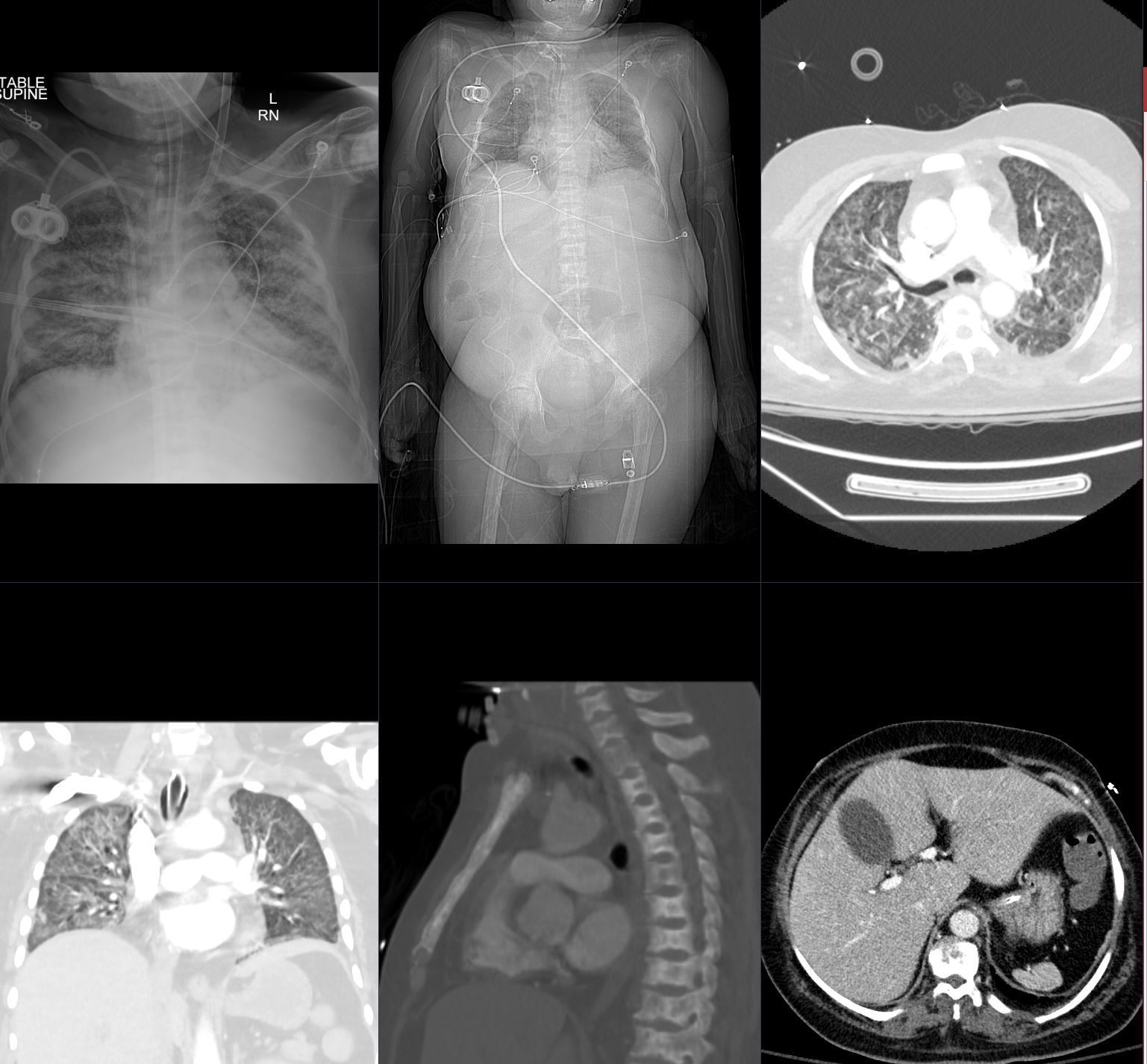
The CXR and CT in this 26 year old male in sickle cell crisis shows diffuse and symmetrical ground glass changes with subpleural sparing best observed in images b and d. The bony changes are characterized by bilateral avascular necrosis of the hips (b) and diffuse sclerosis with fish mouth deformity of the thoracic and lumbar spine (e). The spleen is extremely small but still perfusing (e)
Ashley Davidoff TheCommonVein.net b11662-01L
Patient with HIV Fournier Gangrene ARDS with GGO and focal Consolidations Symmetrical Involvement
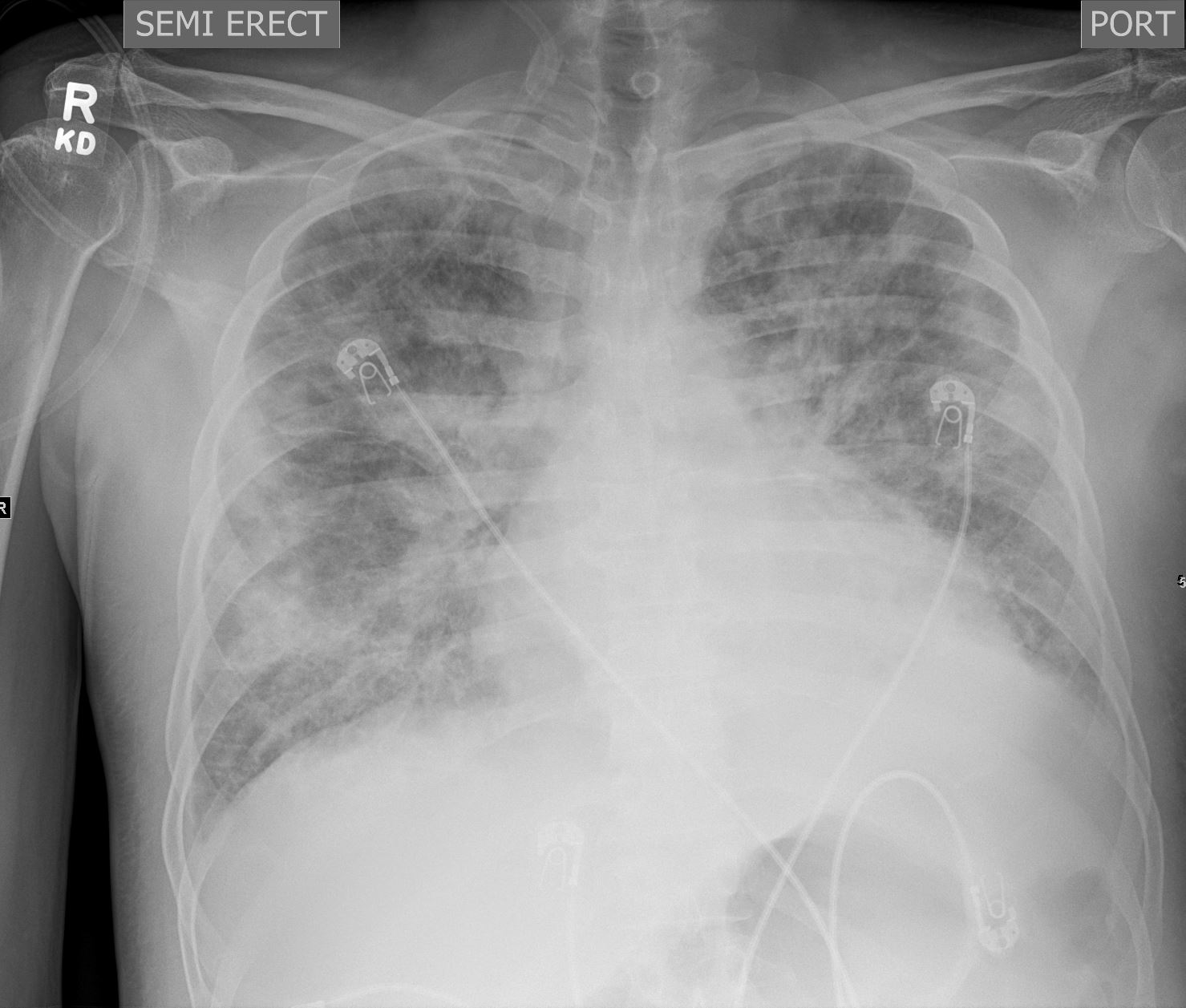
Frontal CXR of a 35 year old man with HIV, and Fournier gangrene presents with ongoing respiratory distress
The image reveals diffuse bilateral multifocal pneumonic infiltrates involving upper and lower lungs bilaterally
Ashley Davidoff MD TheCommonVein.net 284 Lu 136502
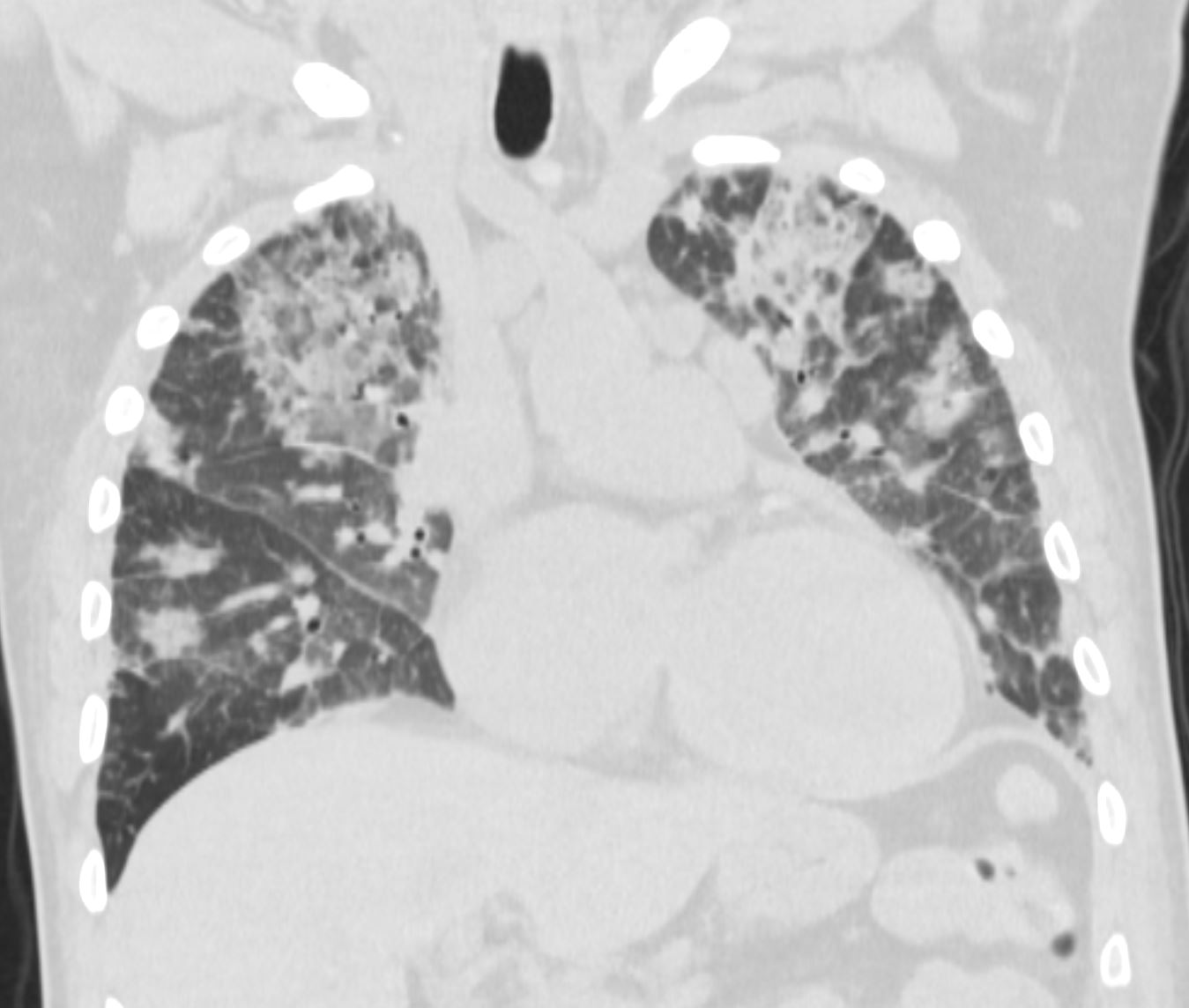
35 year old man with HIV, and Fournier gangrene presents with ongoing respiratory distress
Coronal CT at the level of the left ventricle reveals diffuse bilateral multifocal pneumonic infiltrates (pneumonia) involving upper lungs bilaterally. The infiltrates have a combination of both ground glass and consolidations
Bilateral pleural effusions are present
Ashley Davidoff MD TheCommonVein.net
284 Lu 136505
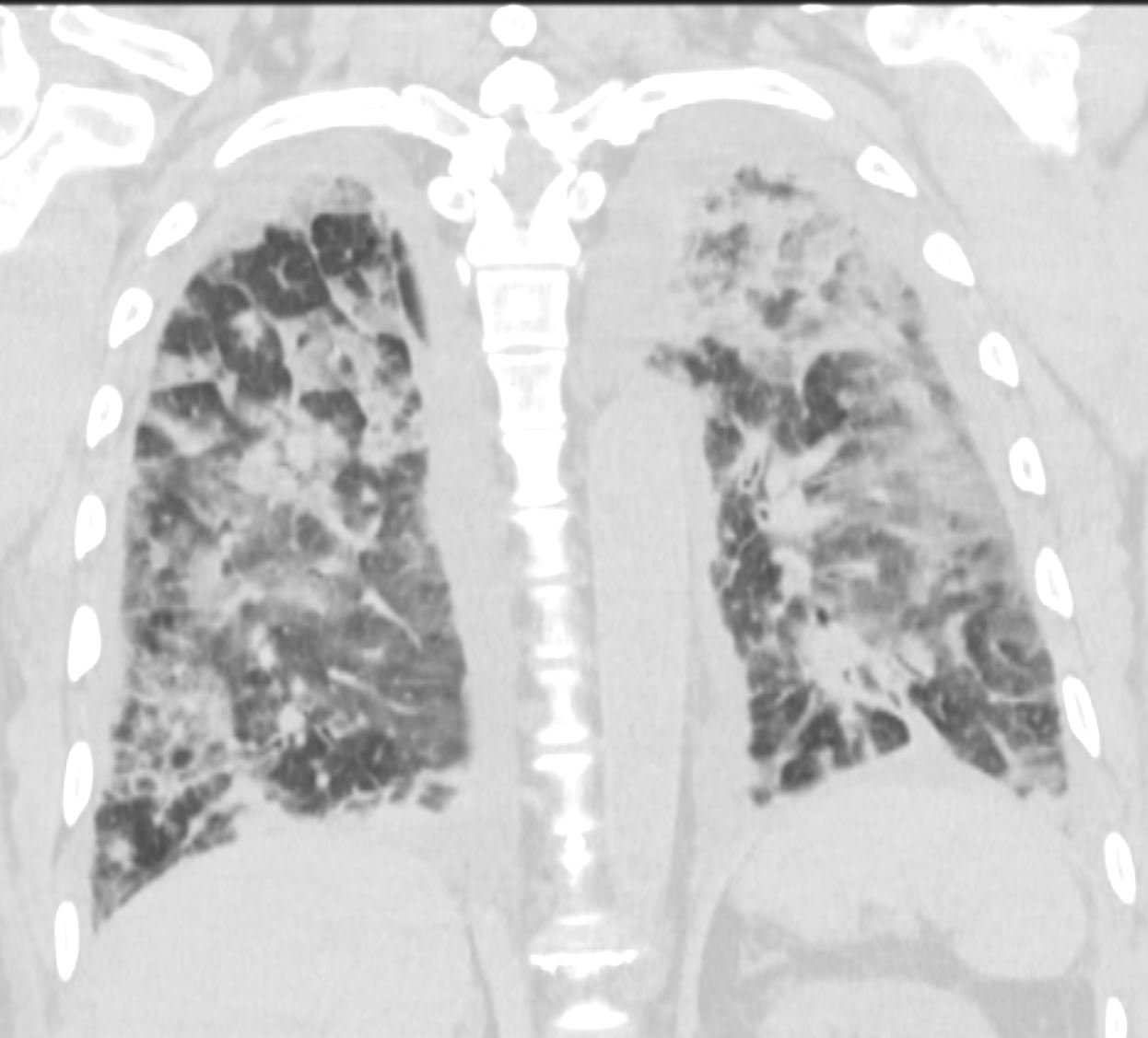
35 year old man with HIV, and Fournier gangrene presents with ongoing respiratory distress
Coronal CT at the level of the spine posteriorly, reveals diffuse bilateral multifocal pneumonic infiltrates (pneumonia) involving upper and lower lungs bilaterally. The infiltrates have a combination of both ground glass and consolidations
Bilateral pleural effusions are present. Thickening of the interlobular septa. Bilateral loculated effusions surround both lungs
Ashley Davidoff MD TheCommonVein.net 284 Lu 136506

35 year old man with HIV, and Fournier gangrene presents with ongoing respiratory distress
Axial CT at the level of the carina reveals diffuse bilateral multifocal pneumonic infiltrates (pneumonia) involving upper lungs bilaterally. The infiltrates have a combination of both ground glass and consolidations
Bilateral pleural effusions are present
Ashley Davidoff MD TheCommonVein.net 284 Lu 136504
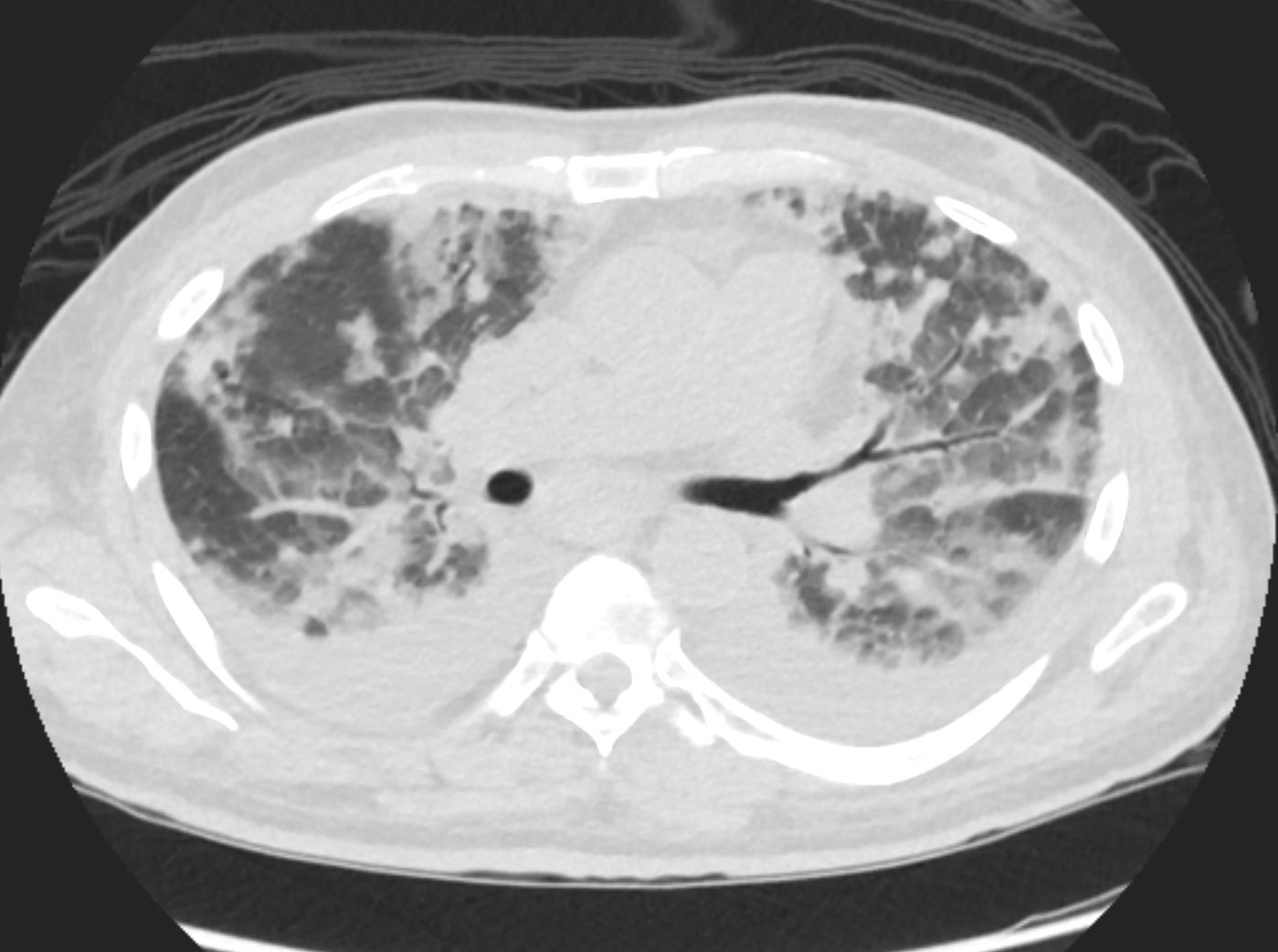
35 year old man with HIV, and Fournier gangrene presents with ongoing respiratory distress
Axial CT at the level of the carina reveals diffuse bilateral multifocal pneumonic infiltrates (pneumonia) involving upper lungs bilaterally. The infiltrates have a combination of both ground glass and consolidations
Bilateral pleural effusions are present
Ashley Davidoff MD TheCommonVein.net
284 Lu 136504
- While ARDS is a clinical syndrome with specific diagnostic criteria based on symptoms, imaging, and oxygen levels.
- DAD is a histological pattern of lung injury, most commonly seen in ARDS but not exclusively limited to it.
- Diffuse alveolar damage (DAD) is manifested by
- injury to alveolar lining and
- endothelial cells,
- pulmonary edema,
- hyaline membrane formation and
- later by proliferative changes involving
- alveolar and
- bronchiolar lining cells and
- interstitial cells
- later by proliferative changes involving
- Diffuse alveolar damage (DAD) is manifested by
- DAD is the stereotypical morphology of ARDS,
- Clinical syndrome of ARDS is not synonymous with the pathologic diagnosis of DAD
- DAD pattern is often characterized by hyaline membranes in acute phase but shows a wide variety of findings that makes the diagnosis challenging
- Buzz in a Nutshell
- Acute
- Diffuse
- Extensive
- bilateral
- without upper or lower lobe predominance
- Can be regional,
- depending on the degree and cause of the inflammation
- Alveoli
- Causes either
- pulmonary or
- severe systemic disease
References and Links
Radiopaedia
- Akira Yoshikawa, M.D., Andrey Bychkov, M.D., Ph.D. Pathology Outlines ARDS / DAD
- Sheard S et al Imaging of Acute Respiratory Distress Syndrome

